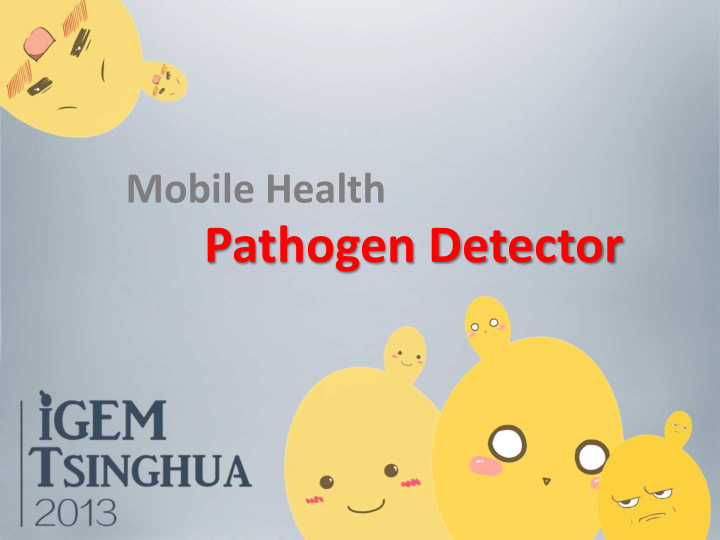



Mobile Health Pathogen Detector
Problem of Pathogen detection • Health is the primary concern in life. • Limited approaches of pathogen detection Identify the pathogen at home thus choose specific medicine? Xiaochen If pathogen in food is conveniently detectable? Xiaoyi
Problem of Pathogen detection — The outbreak of Escherichia coli in 2011 Picture from Case definition for HUS-cases associated with the outbreak in Germany
The idea of Mobile Health • Mobile Health: Make health care accessible at home • Portable Pathogen Detector (PPD) Test Paper Pathogen
Two Key Questions What to target from pathogen ------------------------------------------------------ 1) Detectable 2) Universal 3) Specific What to use in the test paper? ----------------------------------------------------- 1) Portable 2) Stable 3) Safe
Two Key Questions What to target from pathogen ------------------------------------------------------ 1) Detectable 2) Universal 3) Specific What to use in the test paper? ----------------------------------------------------- Yeast Dry Yeast Food Industry
Two Key Questions What to target from pathogen ----------------------------------------------------- AHL What to use in the test paper? ----------------------------------------------------- Yeast Dry Yeast Food Industry
Module design — The system is separated into two modules, which are assembled by mating. · Amplified Signal ·Robustness
Our team
Modules Design
Three novel features 1. Quorum sensing system – Prokaryotic Eukaryotic 2. Diverse combination – Input & Output; Fast & Easy 3. Dry powder – Safe, stable & portable
Quorum sensing-LuxI/R system • Pol II recruitment • Nuclear barrier Work in E.coli √ Work in yeast ×
Modification of sensor module Works in yeast √
Three novel features 1. Quorum sensing system – Prokaryotic -> Eukaryotic 2. Diverse combination – Input & Output; Fast & Easy 3. Dry powder – Safe, stable & portable
Design of reporter module — Interaction between sensor and reporter Sensor Reporter
Sensor
Reporter
Diverse combination by mating Fast, easy, automatic
Three novel features 1. Quorum sensing system – Prokaryotic -> Eukaryotic 2. Diverse combination – Input & Output; Fast & Easy 3. Dry powder – Safe, stable & portable
Why make yeast dry powder? • Easy to store • Save space • Can be fixed on test paper • Recover rapidly
Modeling
Model simulating the process
Model simulating the process
Testing
Modules Testing Pathogen sensor ? Pathogen reporter Dry yeast
Results — Successful expression of LuxR pTF4 Control tVP16-LuxR sensor
Results — mCherry fluorescence observed under microscope • Yeast induced with AHL during exponential phase • Incubation at 30 ℃ , shaking culture Control AHL (24h post-induction)
Results — Quantification of fluorescence by flow cytometry
Modules Testing Pathogen sensor ? √ Pathogen reporter Pathogen reporter ? Dry Yeast
Results — Tet system and ADE2 works in yeast pTF6 Ctrl pTF6
Modules Testing Pathogen sensor √ Pathogen reporter √ ? Dry yeast Dry yeast ?
Dry yeast preparation — Dry yeast viable after three weeks Centrifuge twice Dry in the vacuum centrifuge 30 ℃ 45min Powder kept under Reactivate with Viable after 21+ days room temperature water, grow on medium
Modules Testing Pathogen sensor √ Pathogen reporter √ Dry yeast √ ?
Future Work
Future work AHL specificity Non-AHL detection Combination by mating
Mating makes it easier ×
Modifying a pathogen detector GFP RFP Molecular manipulation Mating • Switch out the gene • Choose another reporter • 1 week or more • At least 6 hours • Expensive • Inexpensive
Potential Applications • Home pathogen detection • Clinical test • Environment monitoring • Many more…
Human Practice
Surveys Potential problems of Mobile health
Movie Series • Introducing interesting biological facts • Emphasizing on interests • Viewed for more than 6,500 times
Short Story
Human Practice --- Collaboration • Survey • Movie Series & Short Story • Collaboration with other team (OUC, BIT) • Association of Synthetic Biology in Tsinghua
Acknowledgements Sponsors: • Prof. Sun Zhirong • Prof. Chen Guoqiang • Prof. Dai Junbiao • Zhao Yu • Li Teng Collaboration: • Xie Hengyi • All team members
References • [1] Lazcka O, Campo F, Munoz F X. Pathogen detection: a perspective of traditional methods and biosensors[J]. Biosensors and Bioelectronics, 2007, 22(7): 1205-1217. • [2] Nassif X. A revolution in the identification of pathogens in clinical laboratories[J]. Clinical infectious diseases, 2009, 49(4): 552-553. • [3] Simon C. Williams et al. Pseudomonas aeruginosa Autoinducer Enters and Functionsin Mammalian Cells. 2004, JOURNALOF BACTERIOLOGY, Vol.186,No.8 • [4] F. Sherman et al. Getting Started with Yeast By Fred Sherman, 2003, Methods Enzymol. 350, 3-41. • Sergi Regot Rodríguez de Mier, Systems and synthetic biology studies in Saccharomyces cerevisiae. 2011, Barcelona. • [5] Quorum sensing in biofilms: Why bacteria behave the way they do? 2009, Journal of Food Science. 74(1): R24 – R37. • [6] Avantika Lal, Quorum Sensing : How Bacteria Talk to Each Other, 2009, RESONANCE 866-871. • [7] Gossen, M. & Bujard, H. Tight control of gene expression in mammalian cells by tetracycline- responsive promoters. Proc. Natl. Acad. Sci. 89 , 5547 – 5551 (1992). • [8] Funahashi, A., Morohashi, M., Kitano, H. & Tanimura, N. CellDesigner: a process diagram editor for gene-regulatory and biochemical networks. BIOSILICO 1 , 159 – 162 (2003). • [9] Basu, S., Gerchman, Y., Collins, C. H., Arnold, F. H. & Weiss, R. A synthetic multicellular system for programmed pattern formation. Nature 434 , 1130 – 1134 (2005). • [10] Goutelle, S. et al. The Hill equation: a review of its capabilities in pharmacological modelling. Fundam. Clin. Pharmacol. 22 , 633 – 648 (2008).
Thank you!
Recommend
More recommend